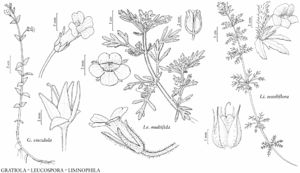Gratiola viscidula
Torreya 19: 145. 1919.
Perennials. Stems decumbent, ascending, or erect, simple, sometimes few-branched, (8–)15–60 cm, sparsely to densely glandular-puberulent or glandular-pubescent proximally, glandular-puberulent distally. Leaves: blade lanceolate-ovate to ovate or oblong, rarely linear-lanceolate in submersed forms, 5–28 × 4–15 mm, margins with (3–)5–10(–12) pairs of sharp teeth, apex acute, rarely obtuse, surfaces sparsely to densely glandular-puberulent. Pedicels slender, 10–23 mm, length 0.5–2 times bract, sparsely to densely glandular-puberulent; bracteoles 2, 3.5–7 mm. Flowers: sepals distinct, lanceolate to elliptic or ovate-lanceolate, 3–7 mm; corolla 9–13 mm, tube yellowish brown, veins blue or lavender, limb white; style 3–4 mm. Capsules globular, 1–2.5 × 1–2.5 mm. Seeds 0.3–0.4 mm. 2n = 16.
Phenology: Flowering May–Oct.
Habitat: Bogs, wet meadows, floodplain wetlands, beaver ponds, stream banks, seeps, shores of ponds and lakes.
Elevation: 0–300 m.
Distribution
Del., D.C., Fla., Ga., Ky., Md., N.C., Ohio, S.C., Tenn., Va., W.Va.
Discussion
D. M. Spooner (1984) examined intraspecific variation in Gratiola viscidula and concluded that recognition of infraspecific taxa is not warranted.
